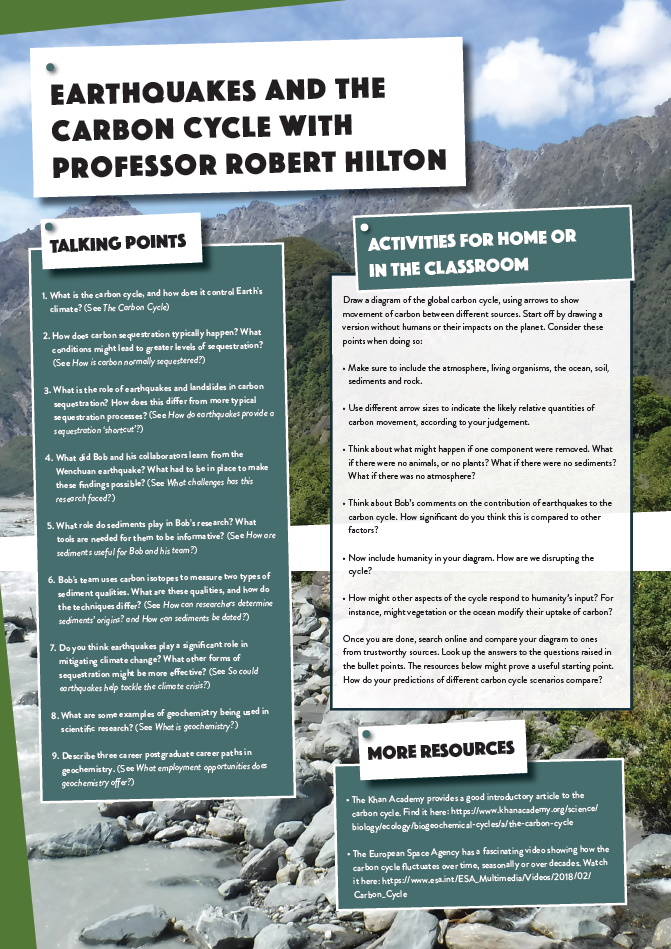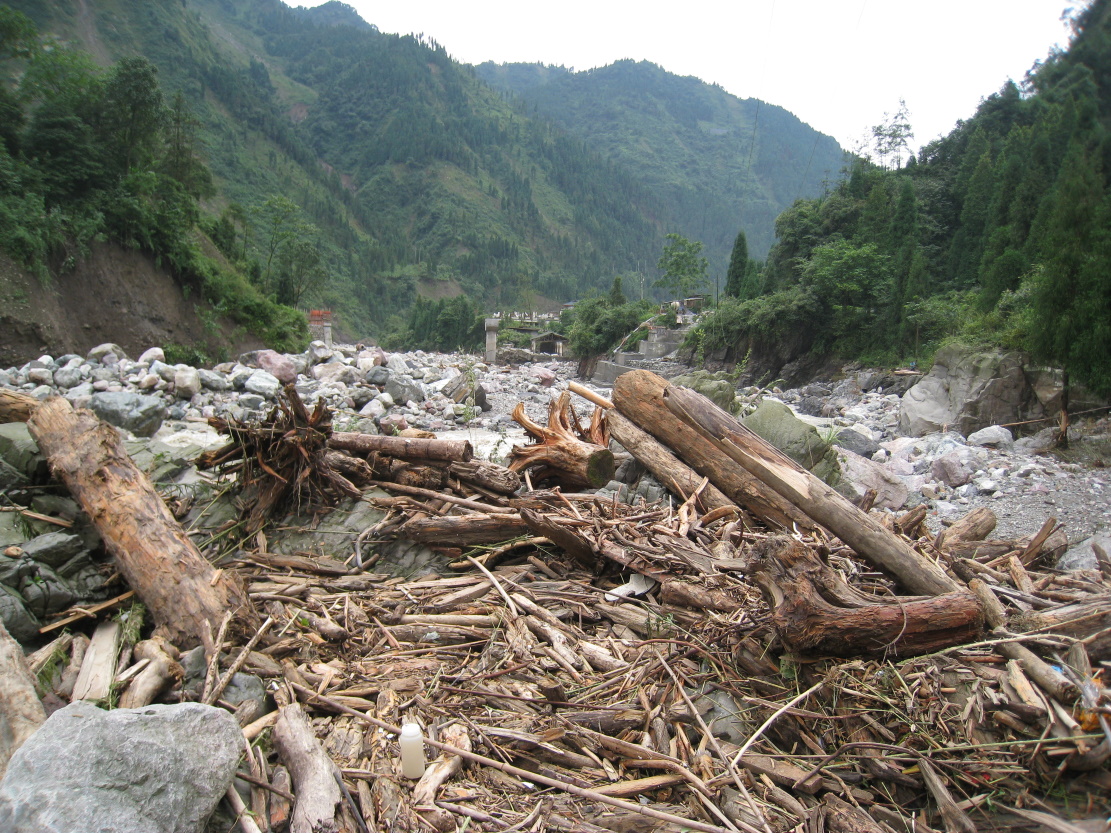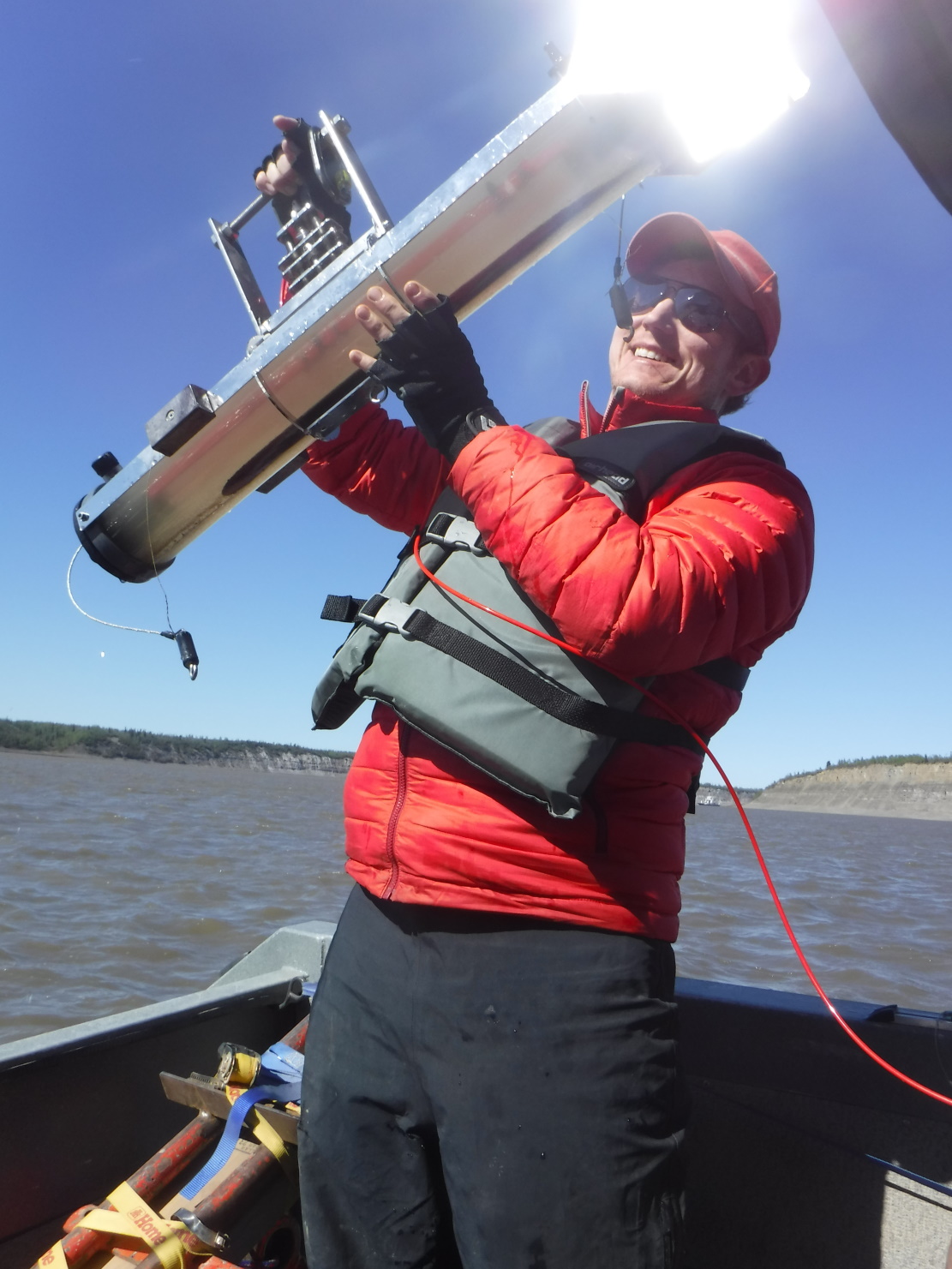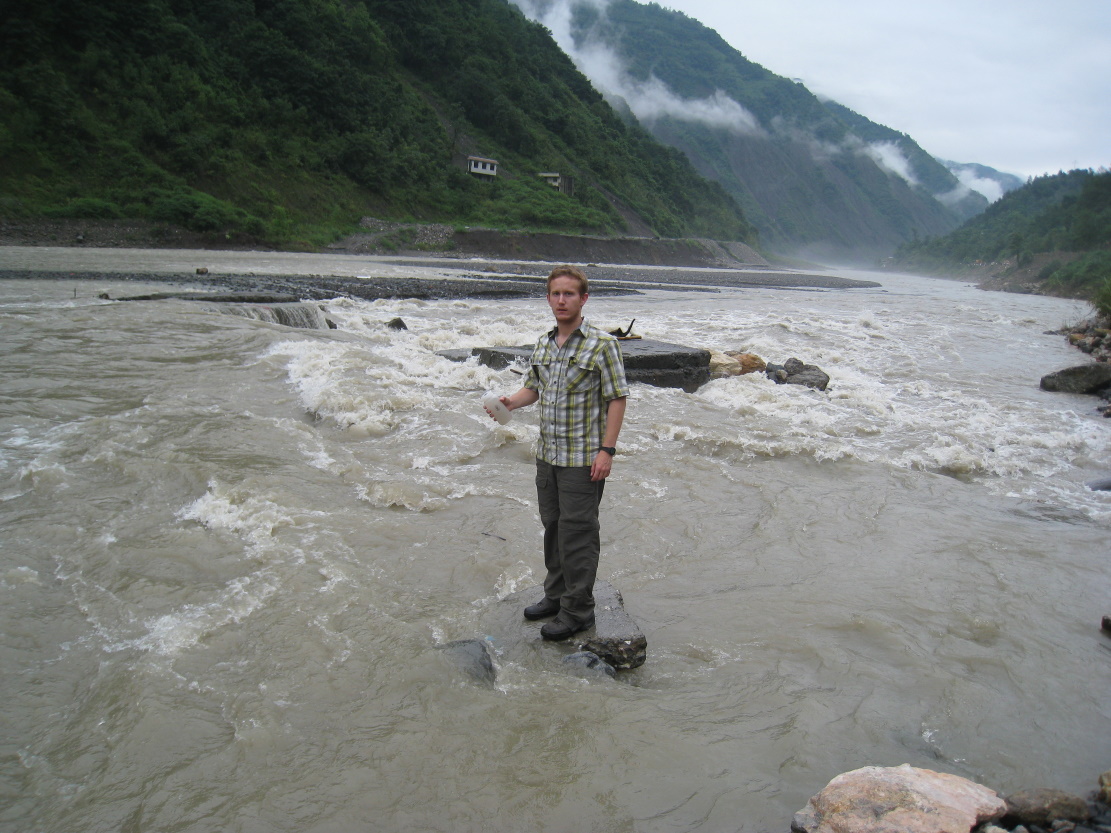The role of earthquakes in burying carbon for good
Carbon is the cornerstone of life on Earth and is constantly being transferred between the atmosphere and the Earth’s surface. This carbon cycle is one of Earth’s most important natural processes and continues to surprise us. Professor Robert Hilton of Durham University has been investigating an intriguing carbon cycle “shortcut”: the role of earthquakes in sequestering carbon
As the carbon cycle becomes increasingly disrupted by human activities, research into how the cycle functions is ever more relevant. Despite its importance in sustaining life, scientists still do not know everything there is to know about the carbon cycle. In many ways this is unsurprising: the processes that make up this cycle happen on a grand scale and rely on interactions between many different factors. Teasing these apart is no easy task, but as science becomes more sophisticated, researchers are able to dig further into the inner workings of this fundamental global flux.
HOW IS CARBON NORMALLY SEQUESTERED?
For carbon to be sequestered (‘locked up’) on a geologically relevant timescale, it must be kept out of the atmosphere for thousands of years, or longer. Much of the carbon stored in plants and soils is cycling back and forth with the atmosphere every day. As soon as organisms decompose, the carbon returns to the atmosphere as carbon dioxide. Longer sequestration only happens when carbon enters sediments (the matter that settles at the bottom of oceans, rivers or lakes) or becomes deeply buried and compressed under many layers of soil. Both are typically gradual processes. Prof Robert (Bob) Hilton is a geochemist working in Durham University’s Department of Geography. He is leading the first ever research project into the role of large earthquakes in carbon storage.
Carbon on Earth can be broadly divided into two main categories. The first is carbon present in the atmosphere, mostly in the form of carbon dioxide. The second is carbon within substances on the Earth’s surface, and within living organisms, soils, sediments and rocks.
In simple terms, the carbon cycle is the movement of carbon between these two categories. Carbon enters the atmosphere through processes like respiration, decomposition, combustion and erosion; carbon is removed from the atmosphere through processes like photosynthesis and sedimentation. Balancing these two flows is crucial to life on Earth, but human activity has disrupted the cycle. Burning fossil fuels, for example, means that the level of carbon entering the atmosphere exceeds that being removed.
HOW DO EARTHQUAKES PROVIDE A SEQUESTRATION “SHORTCUT”?
“Large earthquakes sometimes cause landslides, which move carbon contained in soil and rivers as part of their sediment load. These sediments can be stored for very long periods of time,” explains Bob. “Landslides provide a ‘natural’ CO2 sequestration mechanism and are a fascinating link between earthquakes and the carbon cycle.” Landslides essentially “skip” the gradual build-up of layers of soil or sediment over thousands of years, instead causing a rapid movement of carbon which could promote its longer-term sequestration. “We are trying to see how important these rare events are over thousands of years of carbon transfer,” says Bob. “We can then begin to pinpoint places where this process is especially important, and how it might change over time.”
IS IT DIFFICULT TO STUDY CARBON SEQUESTRATION THROUGH EARTHQUAKES AND LANDSLIDES?
The short answer is yes! As Bob explains, “The role of earthquakes is difficult to assess because they don’t occur very often. But when they do happen, they move a lot of carbon in one go.” To assess the shift in carbon, scientists like Bob need to compare sediments before and after an earthquake. “We can’t predict when and where an earthquake might occur, only recognise places where they are more likely,” he says.
In 2008, a devastating earthquake hit the Chinese province of Wenchuan, causing just under 200,000 landslides. Scientists in China found archived river sediment samples taken in the years immediately before the quake. These samples proved to be a valuable find. “By comparing these to samples collected after the earthquake, we were able to show that the erosion of soils and vegetation led to carbon entering the rivers,” says Bob. “However, we could only look back a few years, and only in one place.”
SO, HOW ARE BOB AND HIS TEAM RESEARCHING CARBON SEQUESTRATION ELSEWHERE?
Bob and his team needed more sophisticated methods of “looking back in time” to find out whether the discovery made in China also happens in other regions of the world, and over longer timescales. Excitingly, the scientists have recently succeeded in developing these methods. “Now we can track carbon – where it has come from, and how long the process took.”
The scientists examine the properties of lake sediments, which provide a snapshot of decades or even centuries past. Rivers feed sediments into lakes over time, so the deeper the sediment, the older it is. The collection method is fairly simple: the researchers push a pipe into the bottom of the lake to extract what is called a sediment core. They then analyse the core using knowledge in chemistry.
WHERE DOES CHEMISTRY COME INTO THE RESEARCH?
“Our main tool for sediment analysis involves carbon isotopes,” says Bob. Isotopes are atoms of an element that have the same number of protons and electrons but a different number of neutrons (and therefore different masses) to one another, which occurs frequently in nature. This doesn’t affect their chemical properties but does give them a unique “fingerprint”, which is very useful for scientists. Carbon-12 and carbon-13 are the most common carbon isotopes and are found in different proportions in various sources of organic matter. This means that even if a sediment appears to be sludge at first glance, by measuring quantities in carbon isotopes scientists can work out how and when it was formed.
HOW CAN SCIENTISTS TELL WHEN A SEDIMENT HAS FORMED?
Analysis of a rarer isotope, carbon-14, can be used to assess when a sediment formed. This radioactive isotope is found in atmospheric carbon dioxide and is taken in by plants through photosynthesis. Once the plants die, carbon-14 begins to decay. A technique called radiocarbon dating measures the amount of carbon-14 left in a sediment sample; the lower the concentration, the older the sediment. “Our colleagues in New Zealand have looked at sediment cores in detail and use this technique to identify when earthquakes happened,” says Bob. “In sediment cores from Lake Paringa [on New Zealand’s South Island], for instance, we can identify that four earthquakes have occurred during the last 1,000 years.”
CAN THIS RESEARCH HELP TACKLE THE CLIMATE CRISIS?
Humanity’s disruption of the carbon cycle has led to a greater concentration of atmospheric CO2 than has been seen for millennia, which is leading to climate change. Could earthquakes’ immediate carbon sequestration help reverse this? “The amount of carbon involved in this process is small compared to the CO2 emissions from burning fossil fuels,” says Bob. “The processes we are studying certainly won’t save the day. These processes naturally regulate the carbon cycle but play out over thousands to tens of thousands of years.”
That said, Bob and his team are answering key questions about how our planet works. The more we understand how the planet works, the more that can be done to save it – and it will take geoscientists and geochemists like you to uncover Earth’s capabilities!
Reference
https://doi.org/10.33424/FUTURUM45
Sampling rivers to understand their carbon transfers.
© RG Hilton
Muddy rivers during floods of August 2010 in Sichuan, China. These flood waters carry sediment from landslides which happened during the 2008 Wenchuan earthquake.
© RG Hilton
Tracking carbon from the Andes mountains to large rivers of the Amazon, in March 2019.
A mountain river draining the western Southern Alps, New Zealand.
© M Ogric
A coal seam in the Longmen Shan mountains, Sichuan, China, where erosion can move carbon from rocks, as well as from plants and soils.
© Jin Wang
As the carbon cycle becomes increasingly disrupted by human activities, research into how the cycle functions is ever more relevant. Despite its importance in sustaining life, scientists still do not know everything there is to know about the carbon cycle. In many ways this is unsurprising: the processes that make up this cycle happen on a grand scale and rely on interactions between many different factors. Teasing these apart is no easy task, but as science becomes more sophisticated, researchers are able to dig further into the inner workings of this fundamental global flux.
HOW IS CARBON NORMALLY SEQUESTERED?
For carbon to be sequestered (‘locked up’) on a geologically relevant timescale, it must be kept out of the atmosphere for thousands of years, or longer. Much of the carbon stored in plants and soils is cycling back and forth with the atmosphere every day. As soon as organisms decompose, the carbon returns to the atmosphere as carbon dioxide. Longer sequestration only happens when carbon enters sediments (the matter that settles at the bottom of oceans, rivers or lakes) or becomes deeply buried and compressed under many layers of soil. Both are typically gradual processes. Prof Robert (Bob) Hilton is a geochemist working in Durham University’s Department of Geography. He is leading the first ever research project into the role of large earthquakes in carbon storage.
THE CARBON CYCLE
Carbon on Earth can be broadly divided into two main categories. The first is carbon present in the atmosphere, mostly in the form of carbon dioxide. The second is carbon within substances on the Earth’s surface, and within living organisms, soils, sediments and rocks.
In simple terms, the carbon cycle is the movement of carbon between these two categories. Carbon enters the atmosphere through processes like respiration, decomposition, combustion and erosion; carbon is removed from the atmosphere through processes like photosynthesis and sedimentation. Balancing these two flows is crucial to life on Earth, but human activity has disrupted the cycle. Burning fossil fuels, for example, means that the level of carbon entering the atmosphere exceeds that being removed.
HOW DO EARTHQUAKES PROVIDE A SEQUESTRATION “SHORTCUT”?
“Large earthquakes sometimes cause landslides, which move carbon contained in soil and rivers as part of their sediment load. These sediments can be stored for very long periods of time,” explains Bob. “Landslides provide a ‘natural’ CO2 sequestration mechanism and are a fascinating link between earthquakes and the carbon cycle.” Landslides essentially “skip” the gradual build-up of layers of soil or sediment over thousands of years, instead causing a rapid movement of carbon which could promote its longer-term sequestration. “We are trying to see how important these rare events are over thousands of years of carbon transfer,” says Bob. “We can then begin to pinpoint places where this process is especially important, and how it might change over time.”
IS IT DIFFICULT TO STUDY CARBON SEQUESTRATION THROUGH EARTHQUAKES AND LANDSLIDES?
The short answer is yes! As Bob explains, “The role of earthquakes is difficult to assess because they don’t occur very often. But when they do happen, they move a lot of carbon in one go.” To assess the shift in carbon, scientists like Bob need to compare sediments before and after an earthquake. “We can’t predict when and where an earthquake might occur, only recognise places where they are more likely,” he says.
In 2008, a devastating earthquake hit the Chinese province of Wenchuan, causing just under 200,000 landslides. Scientists in China found archived river sediment samples taken in the years immediately before the quake. These samples proved to be a valuable find. “By comparing these to samples collected after the earthquake, we were able to show that the erosion of soils and vegetation led to carbon entering the rivers,” says Bob. “However, we could only look back a few years, and only in one place.”
SO, HOW ARE BOB AND HIS TEAM RESEARCHING CARBON SEQUESTRATION ELSEWHERE?
Bob and his team needed more sophisticated methods of “looking back in time” to find out whether the discovery made in China also happens in other regions of the world, and over longer timescales. Excitingly, the scientists have recently succeeded in developing these methods. “Now we can track carbon – where it has come from, and how long the process took.”
The scientists examine the properties of lake sediments, which provide a snapshot of decades or even centuries past. Rivers feed sediments into lakes over time, so the deeper the sediment, the older it is. The collection method is fairly simple: the researchers push a pipe into the bottom of the lake to extract what is called a sediment core. They then analyse the core using knowledge in chemistry.
WHERE DOES CHEMISTRY COME INTO THE RESEARCH?
“Our main tool for sediment analysis involves carbon isotopes,” says Bob. Isotopes are atoms of an element that have the same number of protons and electrons but a different number of neutrons (and therefore different masses) to one another, which occurs frequently in nature. This doesn’t affect their chemical properties but does give them a unique “fingerprint”, which is very useful for scientists. Carbon-12 and carbon-13 are the most common carbon isotopes and are found in different proportions in various sources of organic matter. This means that even if a sediment appears to be sludge at first glance, by measuring quantities in carbon isotopes scientists can work out how and when it was formed.
HOW CAN SCIENTISTS TELL WHEN A SEDIMENT HAS FORMED?
Analysis of a rarer isotope, carbon-14, can be used to assess when a sediment formed. This radioactive isotope is found in atmospheric carbon dioxide and is taken in by plants through photosynthesis. Once the plants die, carbon-14 begins to decay. A technique called radiocarbon dating measures the amount of carbon-14 left in a sediment sample; the lower the concentration, the older the sediment. “Our colleagues in New Zealand have looked at sediment cores in detail and use this technique to identify when earthquakes happened,” says Bob. “In sediment cores from Lake Paringa [on New Zealand’s South Island], for instance, we can identify that four earthquakes have occurred during the last 1,000 years.”
CAN THIS RESEARCH HELP TACKLE THE CLIMATE CRISIS?
Humanity’s disruption of the carbon cycle has led to a greater concentration of atmospheric CO2 than has been seen for millennia, which is leading to climate change. Could earthquakes’ immediate carbon sequestration help reverse this? “The amount of carbon involved in this process is small compared to the CO2 emissions from burning fossil fuels,” says Bob. “The processes we are studying certainly won’t save the day. These processes naturally regulate the carbon cycle but play out over thousands to tens of thousands of years.”
That said, Bob and his team are answering key questions about how our planet works. The more we understand how the planet works, the more that can be done to save it – and it will take geoscientists and geochemists like you to uncover Earth’s capabilities!
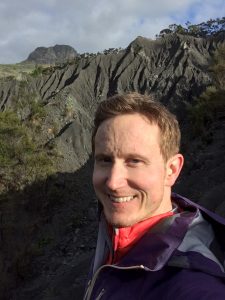 PROFESSOR ROBERT HILTON
PROFESSOR ROBERT HILTON
Department of Geography
Durham University, UK
FIELD OF RESEARCH: Geochemistry
RESEARCH PROJECT: Bob is investigating the contribution of large earthquakes to carbon sequestration, through the transferral of carbon within soil and vegetation into lake and river sediments.
FUNDERS: UK Research and Innovation, Natural Environment Research Council (grant number: NE/P013538/1)
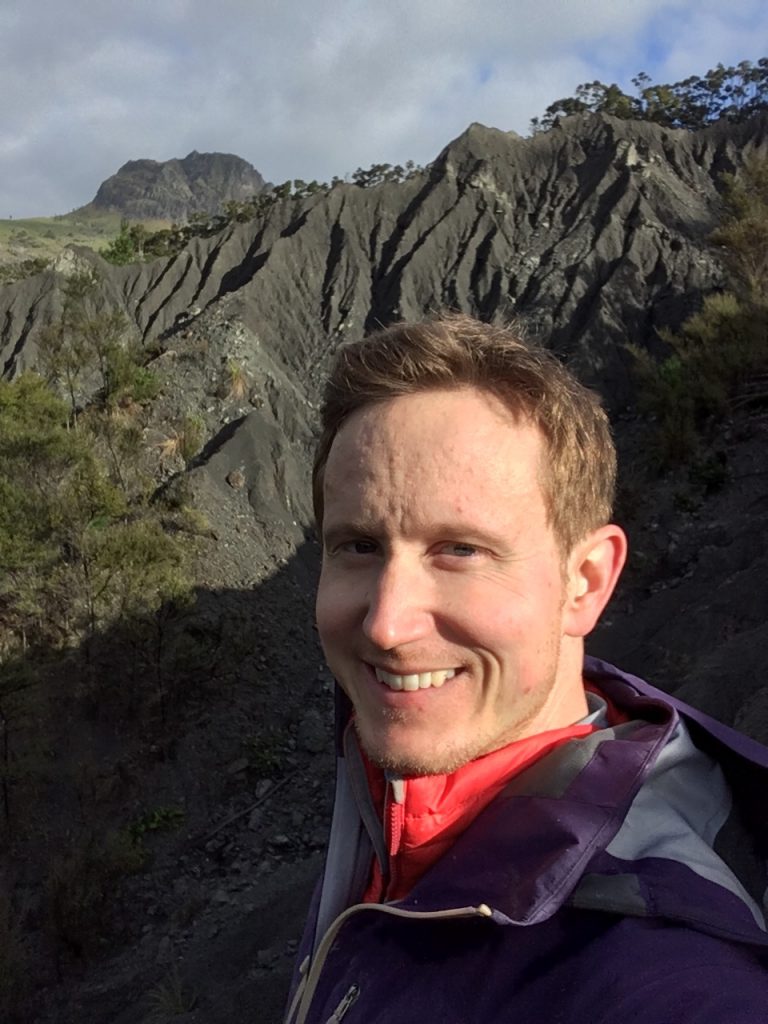 PROFESSOR ROBERT HILTON
PROFESSOR ROBERT HILTON
Department of Geography
Durham University, UK
FIELD OF RESEARCH: Geochemistry
RESEARCH PROJECT: Bob is investigating the contribution of large earthquakes to carbon sequestration, through the transferral of carbon within soil and vegetation into lake and river sediments.
FUNDERS: UK Research and Innovation, Natural Environment Research Council (grant number: NE/P013538/1)
ABOUT GEOCHEMISTRY
“Geochemistry is all about understanding what makes up rocks, soils, water and the atmosphere,” says Bob. “That knowledge is then used to understand the global processes that matter most.” This includes both geological and biological factors – from the materials found in volcanoes to the processes that create soils. “Geochemistry can incorporate broad ‘discovery science’, through seeking to shed light on how the Earth system works, as well as more applied functions, such as tracking the pathway of pollutants in rivers,” Bob adds.
HAVE THERE BEEN ANY MAJOR BREAKTHROUGHS IN RECENT YEARS?
“Yes, lots,” says Bob. “Geochemistry is a very dynamic and broad field, and we are still developing new techniques, so breakthroughs are frequent. For example, there was recently a paper using isotope geochemistry to track the history of Earth’s atmosphere over billions of years.”
WHAT EMPLOYMENT OPPORTUNITIES DOES GEOCHEMISTRY OFFER?
Geochemistry is a broad subject, and as such can lead to a broad range of careers. “There are many environmental consultancies who would welcome people with this background, especially those who have worked on soil or river samples and done fieldwork,” says Bob. “If you are more technically minded, there are opportunities to work in laboratories making measurements or designing scientific instruments.” There are also opportunities involving innovative new technologies such as carbon capture and storage.
If you like the idea of working on research projects like Bob, academia may be the route for you. “Some people go on to PhDs and post-doctoral research positions,” says Bob. “There are many geochemists in geology, Earth sciences and geography departments within universities around the world.”
WHAT HAS BEEN THE GREATEST ACHIEVEMENT OF BOB’S CAREER?
“That is a tricky question, as a lot of scientific research is highly collaborative,” says Bob. “But we’re very proud of some recent new approaches we’ve designed at Durham University to measure the carbon dioxide released from rocks as they are eroded.” These techniques have allowed Bob and his fellow researchers to investigate how this CO2 release is linked to changes in temperature and rainfall.
OPPORTUNITIES IN GEOCHEMISTRY
• A relevant degree is required for most careers in geochemistry. There are no UK undergraduate degrees focusing on geochemistry itself, but Bob says that degrees in geology, chemistry, physics, geography, and environmental science are all good starting points.
• According to Which? University, typical entry requirements for these degrees include at least two A-levels in biology, chemistry, physics, maths or geography. Further maths and geology A-levels can also be advantageous.
• Bob studied Natural Sciences at the University of Cambridge, which is known for high quality of tuition and flexibility in module choices. Entry requirements are typically A*A*A or A*A*A* in two to three science/mathematics A-Levels, depending on college and intended module choices.
ASK PROF ROBERT HILTON
WHAT DID YOU WANT TO BE WHEN YOU WERE YOUNGER?
As a teenager I was in a band, and we clearly all wanted to be in Radiohead. We gave it a shot, and it was great fun. Otherwise, I had a feeling that I wanted to do something that involved new discoveries about how the world worked. I’ve always loved the outdoors, and my dad was a geographer who got me interested in landscapes and why they look the way they do. Once I began studying these areas in school, I knew it was something I wanted to find more about.
WHICH SUBJECTS DID YOU STUDY AT SCHOOL?
I took maths, physics, geography and art at A-level. Geology wasn’t an option at my school; I might have taken it if it had been. I really enjoyed all those subjects, although I was always keenest on the physical side of geography. People are sometimes surprised when I say I have an A-level in art, but I see lots of parallels with the scientific process: observation, recording, research and interpretative re-telling. In science we rely upon visual communication of results and I enjoy thinking about how to do this effectively.
HOW WERE YOU INSPIRED TO FOLLOW A CAREER IN GEOCHEMISTRY?
After school I went on to study natural sciences at the University of Cambridge, which was perfect for me, as I could take modules in physics, geology and materials science in my first year. I thought I would carry on with physics, but really enjoyed the geology course and so selected geology modules alongside physics in my second year, before focusing solely on geology for my third and fourth years.
By the time I was studying for my PhD at Cambridge, I had fantastic mentors who encouraged me to learn and apply geochemical techniques to my research, even though I hadn’t done chemistry since school. I really enjoyed it, and it ultimately led to the research I do now.
DOES TRAVEL FORM A SUBSTANTIAL PART OF YOUR WORK?
It varies quite a lot. Fieldtrips can range in duration from a few days to a fortnight, depending on what we’re trying to get done. I also travel to present our work at conferences and workshops and to teach on fieldtrips. Recently, I’ve had quite a lot of fieldwork travel, which has taken me to some amazing places, such as the Peruvian Andes, Amazon Rainforest and Canadian Arctic.
Although often exhausting, fieldwork can be great fun and I do enjoy it, but I think my favourite part of the job is the reward of getting new data or measurements and seeing what they tell you. This can happen in the field or a year later in the laboratory and results always throw up some surprises. I relish this journey of uncovering what the data can tell us.
HAVE YOU EXPERIENCED ANY EARTHQUAKES?
Yes, a few. In fact, I slept through the 2003 Fjordland earthquake in New Zealand. I was in the field in the Southern Alps, about 200km away from the epicentre, so the shaking was not too intense. When people told me about it the next morning, I thought they were winding me up because I was a geologist! I found out later that it was a large earthquake and caused many landslides, although fortunately Fjordland is quite an empty place.


